
In some cultures, a picture of yourself dressed appropriately for work is an essential part of your resume. Without one, your application might be seen as incomplete, and it could be rejected outright. Since job application photographs aren't standard in the US, you probably don’t know what to look out for when getting your picture taken for an application in another country. This article will give you a good idea of what is required for a job application photo.
The Job Application Photo: Where Do You Need One?
Including a photo with your resume is generally frowned upon in the US and many other English-speaking countries, as this could lead to unconscious bias and discrimination among recruiters. We recommend including a picture of yourself only when your employer explicitly asks for one or when applying for a job in a cultural environment where including a photo in your resume is considered standard practice.
Note that some countries expect applicants to submit a photo even if they have similar anti-discrimination laws as the US. In many regions of the world, you're legally allowed to omit a photo, as employers are forbidden from discriminating on the basis of how you look. However, recruiters in such countries often still expect a photograph and could ignore your application because it's "incomplete" without one.
- Countries in which you don't need to submit a picture as part of your resume include Australia, Canada, Denmark, Ireland, the Netherlands, New Zealand, Norway, Sweden, the United States, and the United Kingdom.
- Countries where including a picture as part of your resume is considered the cultural standard include Mexico, China, France, Germany, India, Italy, Japan, South Korea, Brazil, and Switzerland.
Note how cultural norms regarding photographs in job applications can vary even between close-knit neighbors such as the member states of the European Union. Therefore, you should always research the specific requirements and cultural standards that apply to photographs in your resume before applying for a job overseas. Also note that not all countries that require a picture of you as part of your application have the same attitudes on how you should present yourself in your picture.
Women’s Job Application Photos: The Good and the Bad
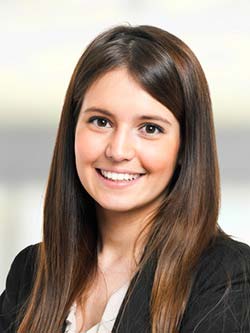
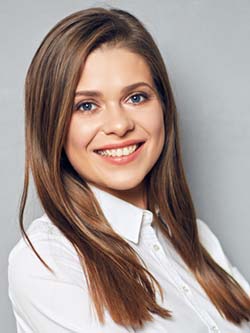
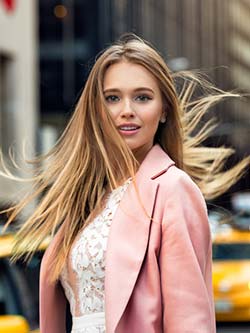
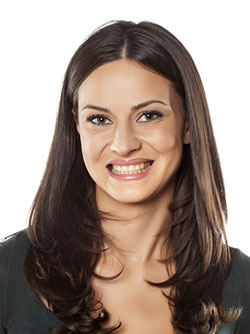
Job Application Photo Tips: Things to Keep in Mind
If your job application picture fulfils all three basic requirements outlined above, that's half the battle won. But there are other factors that contribute to your picture appealing to recruiters. Here are some further tips on how to create the perfect picture for your resume.
Composition and Perspective in Your Job Application Photo
Your job application photo should focus on your face. For a job application photo that's part of your resume, a so-called half-portrait (in portrait format) works best. This way, your head and shoulders are in the frame, but not your entire torso. The lower edge of the frame is usually at chest level, leaving the elbows and waistline out of the picture. In some cultures, it's acceptable to put your photograph on a cover page, in which case you can also use a picture in landscape format.
Avoid frontal shots, as they tend to look confrontational. Instead, turn your body slightly to the side while looking directly at the camera. Also, ensure you have a straight posture and positive body language.
Full-body photos are only acceptable in specific cases. Such as when you're applying to be a model or personal trainer.
It's also important for the photo to show you at eye level, looking directly into the lens. If you're shown looking up at the camera, this can make you look insecure or submissive, while looking down at the camera can make you appear arrogant.
Job Application Photo: Choosing a Background
When it comes to the background of a job application photo, less is more. You should always be the focus of the picture. Any design elements that distract from you are counterproductive. Follow these three rules:
- Simple, quiet background: Most job application photos are taken against a white or gray background. Muted colors are fine—but avoid using bright, saturated colors in the background.
- No intrusive patterns: Heavily patterned backgrounds are a no-go. Floral or rainbow patterns look unprofessional and distracting. You may use subtle, low-contrast background patterns, but exercise caution when choosing one.
- No drop shadows: Drop shadows are caused by poor lighting, making the picture look unprofessional.
Some people like to use business environments as a background for their application photographs. For example, you may take pictures in the lobby of a company or in front of large company windows instead of in a studio. Photographers often deliberately blur the background in such shots so that you're clearly the focus of the picture and that any details in the background don't draw the eye. However, such elaborate photos are not suitable for every job application. If you're applying for an entry-level position, it's better to use an understated photo shot in a studio instead of posing in front of a company building as if you're trying to be the new CEO. Overconfidence rarely sends the right message in a job application, that is, unless you have the professional success to support it.
Authenticity and an Honest Smile Go a Long Way
Try to make a professional impression with your application photo. Keep in mind that recruiters look for reliable employees for their company, not friends to hang out at bars. Still, you should make sure to stay authentic. If you present yourself with a golden tie pin and a slick haircut in your photograph, but you then show up for your job interview wearing casual clothes, this will raise questions. Presenting yourself as someone you're not in your photo usually does more harm than good.
Instead, go for an industry-standard look in your job application photo. Naturally, your clothes play an important role here, but also ensure you're well-groomed: Long hair should be tied back or worn in a simple hairstyle. Men should be clean-shaven or wear their beards neatly trimmed. Stubble is not welcome in your application photo. Understated jewelry and make-up are acceptable.
A friendly, open smile will go a long way to make you look appealing to recruiters. But once again, authenticity is important. If you find it difficult to relax in front of the camera and your smile comes across as forced or artificial, this will put recruiters off. When in doubt, let the photographer take several pictures of you, both with a smile and without one. Afterwards, ask your friends and family to compare which of these pictures makes you look more appealing.
If you have trouble smiling in front of a camera, don’t hesitate to refrain from forcing a smile. Coming across as authentic and charismatic is much more important. And you don't need a smile to achieve this effect. In fact, some cultures may even prefer a serious, professional expression on application photographs.
Men’s Job Application Photos: The Good and the Bad
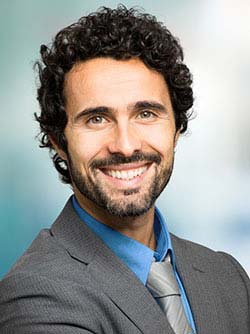
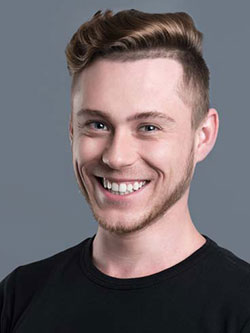
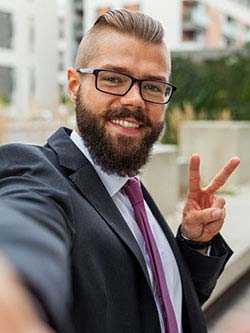
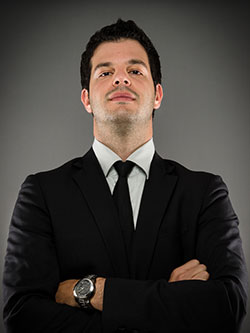
What Should I Wear in a Job Application Photo?
Many applicants are unsure about what to wear for their job application photo. However, there's really just one simple rule of thumb you need to follow:
Choose an outfit for your job application photo that you would also wear to the job interview. If you don't intend to wear a jacket and tie to your interview, you don't need to wear them in your job application photo either.
There are a few ways in which you can determine what to wear in your job application photo:
- Consider the industry and position for which you're applying: Banks tend to have a stricter dress code than marketing agencies. If you're applying for a job as a media designer, you could present yourself wearing a high-quality single-color shirt or long-sleeved shirt, but if you're aiming for a job as a bank clerk, a suit and tie is the expected norm.
- Browse the company's website and social media: It's a good idea to check how your future co-workers present themselves in places like Xing or LinkedIn, and how they're presented on the official company website or in printed ads.
- Ask the company: Many candidates are reluctant to ask HR departments about the expected dress code in advance. However, it can be a good idea to make contact, as HR staff will be able to tell you exactly what they expect from applicants. Additionally, you can use this opportunity to emphasize your interest in the job and demonstrate your communication skills. There are risks to this approach, though, as some recruiters may interpret your questions as a lack of confidence and independent decision-making.
As a general rule, your clothes should be clean, wrinkle-free, and in immaculate condition. Men can almost always get away with wearing a business shirt. A jacket and tie are only required in very few industries. Women are usually on the safe side wearing a conservative blouse—a full suit is rarely required for your application photo.
AI-Generated Application Photos: Never a Good Idea
Today, AI chatbots are already being used to write job applications, and artificial intelligence also promises to allow you to create job application photos in just a few clicks.
Services such as Remini or playground.ai allow you to generate an application photo by uploading a few pictures of yourself, promising better results the more pictures you upload.
There are some real disadvantages to using AI for your application photo, however. First and foremost, many people can tell immediately that these images are AI-generated. This is mainly due to the way AI renders your skin to look artificially smooth and flawless. Hands are another way to quickly tell if a picture has been artificially generated or modified, as many AIs still have trouble determining the proper number of fingers on a human hand. In addition, many of these image generation services aren't free aside from a short trial period.
There's currently no way to predict how recruiters react to AI-generated photos in general. But it stands to reason that once they realize a picture has been generated or "enhanced" with AI, they could get the impression that you're not motivated enough to invest the time and money needed to have someone shoot a professional photograph of you. Some recruiters may even take it as a sign of disrespect.
Keep in mind that some employers, particularly in technical and creative industries, might be thrilled by your ability to work with AI tools. If you're applying for a job that involves working with AI, you may even want to be open about the fact that you've used AI tools to generate the image, so it won't feel like you're trying to deceive the recruiter.
The technology behind generative AIs isn't yet mature enough to create truly authentic-looking application photos, so we recommend that you have your picture taken by a professional photographer instead. This is currently the only way to provide recruiters with an authentic visual impression of yourself.
Job Application Photo: Frequently Asked Questions
Job seekers often wonder what makes a great job application photo and how to get one, especially if it's their first time applying in a country where including a photo is common practice. To help you feel more confident, we’ve gathered some of the most frequently asked questions about job application photos right here for you!Do you need a job application photo?
In the US, the answer is usually "no", unless your prospective employer specifically requires you to include a picture of yourself with your application. In fact, including a picture when it's not explicitly required may send the wrong message to an employer. But when you're applying for a job in another country, you may be required to include a photograph of yourself. Make sure you check beforehand whether a job application photo is considered standard in the country where you're applying for a job.
Where do you put the photo in your job application?
Photos in portrait format usually go in the top right-hand corner of your resume. When submitting your application online, make sure that the image quality is good enough so that the image isn't pixelated. If your prospective employer requires you to provide a printed application, glue the photo in place instead of using paper clips. If your application has a cover page, you can also place a picture in landscape format there instead.
What is the correct size for my job application photo?
In most European countries that require application photos, these should be slightly larger than a passport photo, with a standard size of 2 × 2.5 inches. If you place your job application photo on a cover page, you have more freedom to choose the size of the photo and to adapt it to the design of your resume.
How much does a job application photo cost?
Since job application photos aren’t the norm in the US, photographers often don’t have a clear pricing structure for this type of photo. Professionals may charge as much as $100 or more for professional photos including consultation, retouching or even styling. Make sure they don't just try to pass off a passport photo in a larger format as a professional job application picture.
Can you take a job application photo in black and white?
Usually, recruiters also accept job application photos in black and white. Ironically, this makes choosing the right photographer even more important, as black-and-white photographs require a careful eye for contrast. Black-and-white photographs typically give you a more serious, classic look, however, this may also turn off recruiters. Black-and-white photos tend to work best in conservative business environments.
Should you wear a tie in your application photograph?
Whether you should wear a tie depends on the dress code of the company and the industry standard. If you feel that you don't need to wear a tie to the interview, you probably don't need to wear one in your photograph either. But if a suit and tie are standard for the industry, you should definitely wear them in your photo. This is usually the case when applying for a job with banks, insurance companies or other companies in the financial sector.

